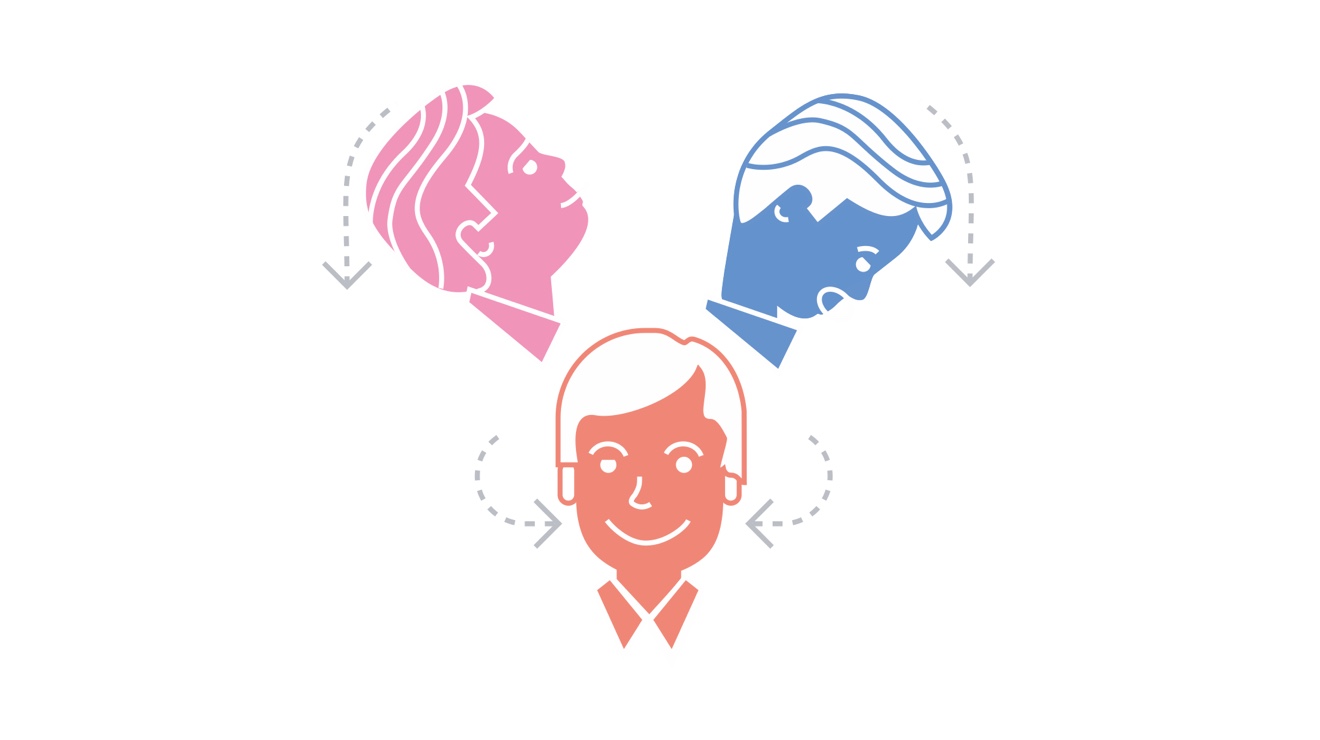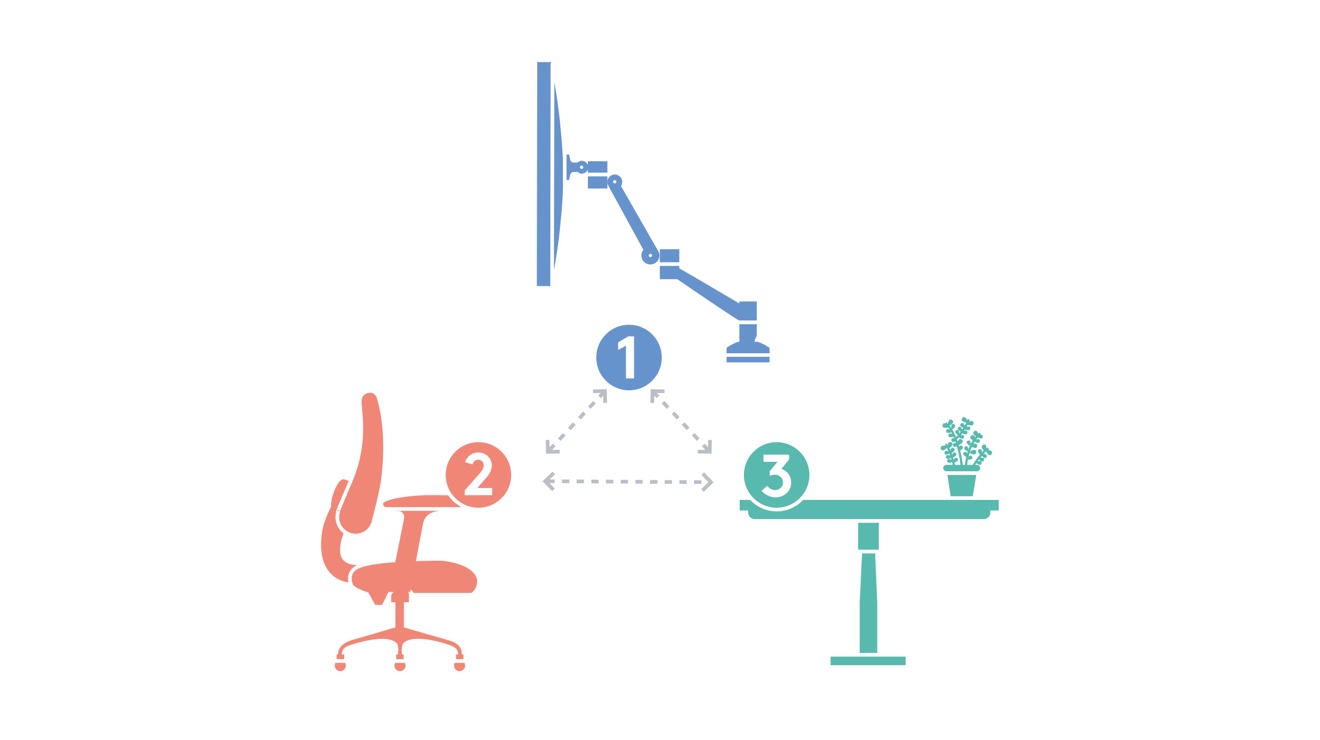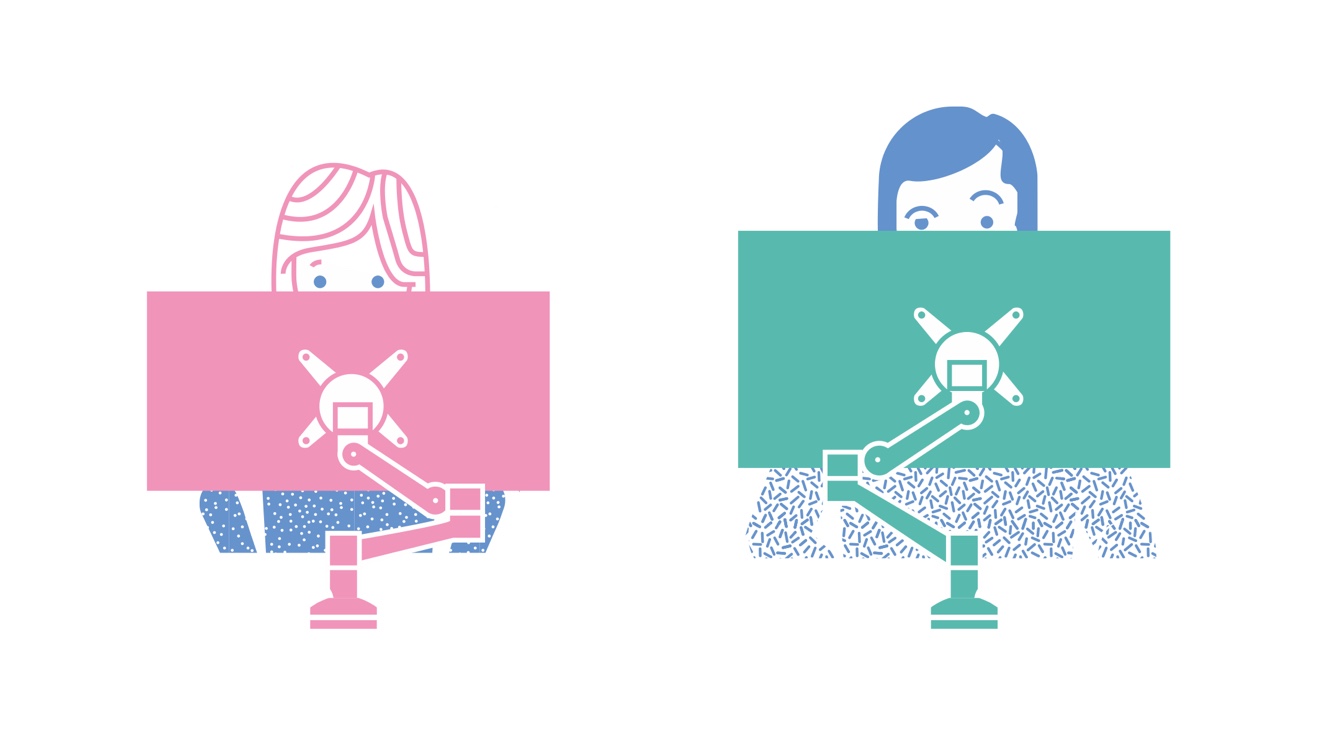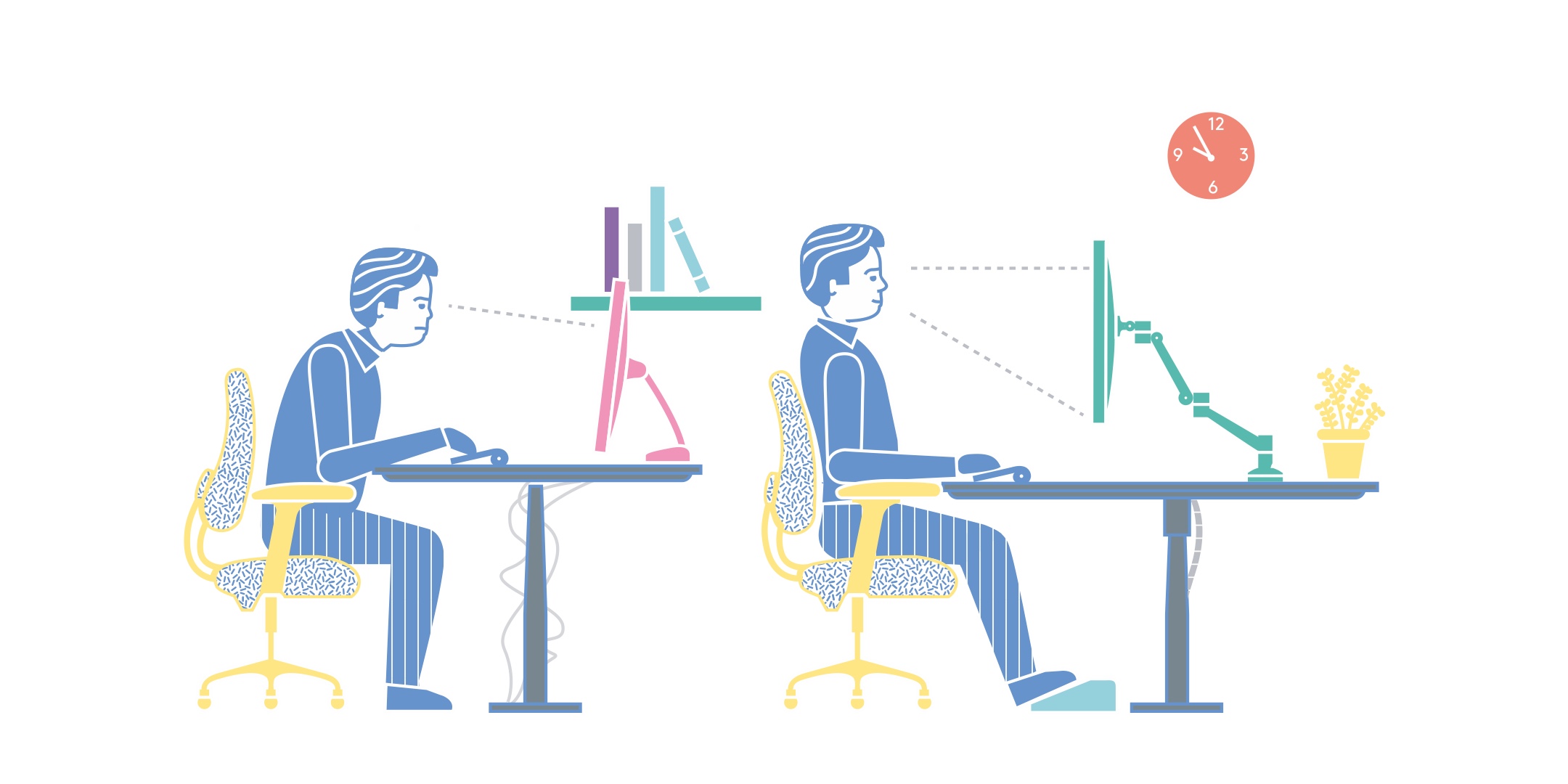How to get yourself shipshape in ergonomics
Dataflex designs ergonomic products to enhance the physical and mental well-being of the people who use them.
To achieve a truly efficient, comfortable and healthy workplace, we believe you have to look at ergonomics from a broader perspective. This is why Dataflex designs products that complement ergonomic chairs and desks to form a ‘golden triangle’ of office ergonomics.
What is ergonomics?
Lots of people have a vague notion of what ergonomics is or should be. They usually mention comfort and physical health in relation to the workplace. While these are certainly aspects connected to ergonomics, these descriptions lack depth. We would like to give you a more accurate description, so that you have a better understanding of what ergonomics is exactly.
Ergonomics, two definitions
To really understand what ergonomics is about, it is important to be aware of the fact that it has two distinct elements. First of all, ergonomics is a science, dedicated to understanding the way humans interact with other parts of a system. Second to that, ergonomics is a profession, where the theoretic principles based on the science element are applied to design and engineering. The goal of this being the optimization of human well-being and productivity. These optimizations are found on both the psychological and physiological sides of human interactions and, as such, can be quite broad in their nature.
Types of ergonomics
The aforementioned broad optimizations can be classified into three main types, which we’ve explained below.
Physical ergonomics
Generally the most well known type, which entails everything purely physical. These are the settings of your chair or the angle at which you view your computer screen.
Cognitive ergonomics
Most of the relevant mental processes belong to the cognitive side of ergonomics. Think of the amount of stress and work-load you’re dealing with and whether you’re properly trained for the work you’re expected to do, but also whether you find your office inspiring or depressing.
Organizational ergonomics
Lastly, organizational ergonomics come into play, which is certainly no less important than the other types. Different policies and processes, like teamwork, communication lines, resource management and scheduling, can all affect the way you function at work and are hence part of organizational ergonomics.
An ergonomic workplace
Asked what an ergonomic workplace is, many people will mumble something about height-adjustable desks and chairs. But as said, it goes much further. Broadly you can break the ergonomic workplace down into 3 key topics: environment, activity and workstation.
Environment
Research consistently finds that various aspects of your broader working environment can have a negative or positive effect on your performance. Some of the key areas you should consider include:
Light and lighting — As interior designers know, having the appropriate amount of light in a workplace is important for a number of reasons. People receive some 85% of information through their sense of sight. So proper lighting makes all work tasks easier and appropriate lighting, without glare or shadows, can reduce eye fatigue and headaches[i].
Acoustics — Research suggests that productivity can be reduced by up to 66% while trying to perform knowledge-based tasks in a space where other people's conversations are clearly audible[ii]. But total silence is not the answer either, as it can be oppressive and intimidating — try making a phone call in a silent room full of people. The answer is the right level of ambient noise or ‘masking sound’ (normally around 50-60 decibels) to mask conversations without being so loud people can’t concentrate.
Climate — Everyone knows there’s nothing worse than when the airco collapses on a hot day or the heating system breaks down in the middle of winter. But research confirms that getting the temperature just right can have a big impact on performance. One study found the optimal temperature for performance to be around 22°C, but perhaps even more tellingly that performance falls away significantly with extreme office temperatures. So at 30°C, for example, people performed at only 91.1% of their maximum capacity[iii].
Well-organised workplace — Many already assume that a tidy workplace makes for a productive one, but the benefits go further than you might realise. Working in a neat, organised environment can relieve stress and help you think clearer. It’s healthier, with fewer germ-carrying dust particles, and reduces the chances of Health & Safety digressions, such as stray computer cables. It’s also more secure for any organisation that has confidential documents. Equally important, a neat and tidy office makes a professional, efficient and reliable impression on visiting clients, partners and job applicants.
But before your company starts issuing too many edicts… research[iv] does indicate that a tidy setting makes people less inclined to commit crime and be more generous, but it has also found that a messy environment can make people more creative and less conventional thinkers — qualities in high demand with many employers. The two are not mutually exclusive, of course. So while there are some clear, easy gains to be made by improving your office environment, organisations should also recognise that no-size-fits-all. A really smart organisation will look for a flexible, open-minded solution.
Plants — The days when a nice pot plant in the corner was just an afterthought by an attentive receptionist are long gone. At least they should be. Because research[v] consistently confirms the positive impact of plants on office workers. In one study, stress levels and negative feelings were reduced among office workers who had plants in their offices by 30-60%. While those without plants saw increases in stress and negative moods of 20-40%. And this over a test period of only 3 months with the researchers finding that just one office plant could make a major difference.
Activity
The price of inactivity
Another key factor effecting your efficiency and well-being at work is how active you are. This especially affects people with sedentary work, including the millions of office workers who spend most of their day sitting behind a desk. The lists of widely-researched effects of a sedentary lifestyle[vi] does not make for pleasant reading and includes higher risks of: anxiety, cardiovascular disease, deep vein thrombosis, depression, diabetes, high blood pressure, obesity, osteoporosis, kidney stones, neck pains, pinched nerves and lower back pain. And this list is by no means exhaustive.

Sport alone is not the answer
But if you think these only affect the die-hard couch potato, think again. Generally speaking, these risks are higher among those that sit still for more than 5 hours a day. And perhaps even more food for thought is that it has been shown to remain a risk factor regardless of your BMI (Body Mass Index) and independent of whether or not you also take strenuous exercise. In other words, the effects of a day slumped behind your PC are not erased by a brisk 10k cycle home from work, or an evening Pilates lesson or rugby training.
Break up the shutdown
But there is good news. Research increasingly suggests that a major part of the problem is sitting for long, unbroken periods, which some researchers believe causes our body to go into a sort of shutdown[vii]. This in turn suggests — and research backs up this view — that by regularly breaking up that inactivity during the day you can significantly reduce the risks of all these negative effects.
So what should you be doing to avoid that bodily ‘shutdown’? Most experts recommend getting up from your sitting position for a few minutes at least once every hour. If you literally just get off your butt and walk around that’s better than nothing, but many of those same experts also recommend their own series of light exercises.
Exercise routines
These can range from the common sense tips in this short video, to a specific series of stretching exercises (PDF).
Tip: Many of the exercises here may not be new to you. But the point is you need to do them. Install a software programme that encourages periodic brief exercises or even put a “Get Moving!” reminder in your electronic calendar to pop a few times a day. At least until it becomes something that you do automatically – because habits can be good as well as bad.
A change is (almost) as good as a rest
Mental fatigue is another issue for those who don’t take a break from their screen. It’s been found that switching to another task can help here. Ideally this will also involve some physical movement, but one study found that computer-based workers who spent up to 20% of their work time surfing the internet were on average 12% more productive than those goody-two-shoes colleagues who didn’t[viii].
Hydration
As we all know, water is literally vital to our well-being[ix]. But while we know to rehydrate when, for example, doing sports, we can sometimes forget to have the odd sip of water during work. Contrary to what you may read in some places, it doesn't have to be buckets. Just remember to ask yourself ‘do I feel thirsty?’ and if you do, drink a little water. Also if your urine is a darker yellow you may not be drinking enough.
Though it’s true that fruit juices, tea, coffee and even soft drinks are all hydrating, why not keep it simple and treat your body to something pure? It also doesn’t have to be expensive mineral water. Studies have found that in many places the local tap water is actually purer than bottled water. So enjoy a glass of Chateau Municipale!
Tip: keep a bottle of water at your desk. When it’s empty you’ll have to move to fill it up again
Get fit, keep fit
And don’t forget: good old-fashioned exercise outside work remains a very positive thing. Research suggests that people who exercise at least 4 hours a week are likely to be as healthy as those who sit fewer than 4 hours per day but do no other significant exercise. But as indicated above, doing a sport alone is not enough.
Workstation
A limited picture
When the topic is so diverse, why do so many organisations, just like so many people, tend to think ergonomics is only about the correct positioning of desks and chairs?
One possible explanation is that if a person can’t work comfortably and report having regular pains in their back, neck or shoulders — or worse still, regularly calls in sick — there is likely to be something wrong with their posture. Complaints of this sort ring alarm bells within management and Occupational Health, triggering action. With the result that the physical ergonomics of the workplace are usually addressed first. And in many organisations that’s as far as it goes. Thus in the minds of many managers and workers ergonomics = correct desk-and-chair positioning.
Beyond desks and chairs
Obviously physical ergonomics are a crucial component of ergonomics as a whole, and the foundation of comfortable and healthy working, because they facilitate a correct posture. However even here, by limiting their attention to desk and chairs, organisations miss the third vital part of the equation: monitor arms, perhaps because until just a couple of decades ago a computer monitor on your desk was relatively new in most organisations.

The 3 pillars
The three pillars of chairs, desks and monitor arms form a kind of ‘golden triangle’ of physical ergonomics, because each pillar plays an equal role in determining your posture in relation to the other two. Here’s how things go wrong:
When the monitor on your desk is not set at the correct height and distance, you will inevitably begin to slouch: either leaning in too far over your desk or too far back from it. We do this unconsciously, so before you know it you’ve been peering at your screen for half an hour with poor posture. With your eyes constantly trying to find the ideal distance and angle to the screen, your head adjusts accordingly. And the neck and back automatically follow, no matter how well your chair and desk have been adjusted to fit your body and requirements.
So if you’re wondering why, despite all your efforts to set your chair and desk in an ergonomically correct way, you still have those niggling neck aches, lower back pains or other symptoms, the answer may well be the oft-forgotten crucial third part of the trinity: your monitor arm’s position. If an organisation makes sure its people get that right, too, it really will be sitting comfortably.
Getting it right
There are numerous guidelines out there to help you set up your workstation correctly. Just make sure you use one that takes equal account of all 3 key elements: desk, chair and monitor arm, for example: Posture guidance (PDF).

An ergonomic organisation
Even if they weren’t before, the reasons why ergonomics should be important to any right-minded organisation are probably by now pretty obvious. If good/bad ergonomics at an individual level can have such a positive/negative effect on an individual’s physical and mental health and general well-being, then that effect simply multiplies for an organisation:
The bottom line
Productivity
‘Workers who don’t feel well don’t perform well’; ‘you will work better in an office environment conducive to that work’. Over-simplifications for some individuals, perhaps; but certainly not when taken across the workforce as a whole. There have been countless studies showing that introducing an appropriate ergonomics process improves productivity[x]. In one study of office workers, it was found that error rates dropped 25%, while there was a 40% increase in active work time (time spent on actual task).
Costs savings
They say good ergonomics is good economics, and the numbers more than bear that out. In the US, 1 in every $3 in workers’ compensation costs is attributed to MSDs (musculoskeletal disorders). And generally most physical ergonomic symptoms are MSD-related. So systematically reducing physical ergonomic risk factors will for the average employer mean making significant inroads into 33% of their compensation costs.
But illness and injury have both direct and indirect costs. Most organisations have a fairly good idea of their direct costs. But hearing that the US Dept of Labor calculates that indirect costs reach up to 20 times those of the direct costs of an injury might concentrate the mind of management even more.[xi]
Absenteeism
The ultimate negative effect of poor ergonomics is of course people being forced to take sick leave. This can also have a negative impact on direct co-workers, who have to cover additional work to the detriment of their own core activities, as well as to the general morale of the whole team. Figures vary enormously of course but studies consistently find that following implementation of robust ergonomic policies worker absenteeism levels decrease. One 1990s study by the US Labor Dept found by redesigning workstations (adjustable ergonomic chairs, task lights, acoustical panels) and increasing space, productivity increased 10-15%, while absenteeism fell by 14%[xii].
Well-being and positive attitude
Perhaps unsurprisingly, studies also confirm the positive impact of good ergonomics practices on employees[xiii]. Aside from the fact that people feel better and therefore perform better, they will likely also have a more positive attitude to you as an employer. This comes from a conscious and sub-conscious ‘cocktail’ of feeling good, having colleagues who feel good, creating a more positive general workplace atmosphere, appreciating your employer’s efforts to create a fine workplace for you (perhaps in contrast to previous employers) and so on. It’s easy to see that there are a number of mutually beneficial virtuous circles working together here like cogs. And of course replace good ergonomics with bad practice, and all those cogs reverse and start generating vicious circles of stress, pains, low morale, negative feelings towards the employer, lower productivity, absenteeism, etc.
Good ergonomics: tailor-made not off-the-peg
You might be forgiven for thinking that an organisation has only to make a list of the above areas for ergonomic improvement, download some guidelines on posture, exercise, get someone in to have a look at the lighting and acoustics, shove a pot plant in the corner of every office and you’re away. Not quite.
Every organisation is unique
Every organisation is unique. This is of course a cliché. And like most clichés, it happens to be true. And that uniqueness can have a major impact on certain aspects of your organisation’s approach to ergonomics.
Contrast, for example, the physical ergonomic requirements of a ‘traditional' company where most people work 9-5 at the same desk every day with that of a large consultancy that has embraced the NWoW (New Ways of Working) philosophy.
At the traditional office each employee can adjust their personal workstation to their individual, largely unchanging needs. At the consultancy people come and go all day long, take a seat at any available hot-desk, maybe using their laptop or tablet, maybe an available desktop. And then there are the meeting rooms, collaborative workspaces, lounge workplaces and so on. A policy for such an organisation will on the one hand probably have to pay far more attention to education than the traditional employer, and on the other have different criteria when purchasing its office furniture and accessories.
Good practice evolves
In a fast-changing digital world, organisations also need to be constantly reviewing and revising their ergonometric practices. Two good examples are software and tablets.
Just a few years ago no one worked on a tablet. Today many people do, tomorrow who knows - and that’s the point: no one knows. People using tablets tend to hold them for long periods of time in awkward positions that they wouldn’t dream of adopting with a traditional desktop or even laptop. Generally they’ll hold them in a way that feels comfortable, but that may mean they’re unconsciously ‘making the best of a bad job’ by getting as comfortable as they can given that they have to hold a screen they also use as a keyboard[xiv].
Software is another case in point. In good software programmes, tools for particular tasks, say page layout in an editing programme, are clustered in intuitive and/or logical sets and sub-sets. This is a simple example of good cognitive ergonomics[xv]. It helps the user, making their work more efficient and enjoyable. But much software has the opposite effect: chaotic, illogical interfaces that slow the user down, stop them finding what they want, raise frustration, and generally tire people out and put them in a bad mood.
Company culture
Take the two previous examples about software and tablets. What would be the right next step: issue a directive to everyone on how they should hold their tablet and ban all software that does not comply with certain criteria? Put an article in the company newsletter with a link to some good practice articles? Or ask local managers to discuss it with their teams and come up with a solution that works best for them? As you’ll have guessed, there is no correct answer. It depends on your company culture (and these answers all assumed we’re talking about a large organisation, a 5-person design agency is something very different again). You have to do what will work best for your organisation.
Another culture-influenced area is Activity: some organisations try to get their employees moving through exercise classes at lunch or entering a team for the local half-marathon. Others offer employees cholesterol and blood pressure screenings. Like most things in working life, it all depends on your people, your circumstances and your style.
How Dataflex can help
At Dataflex we specialise in one aspect of the physical ergonomic picture: developing award-winning monitor arms, toolbars, document holders and many other ergonomic computer workplace accessories. But because we specialise, and have been doing now so for almost 40 years, we can offer you the expert advice you need to help you in this important part of your ergonomic process.
Read more- Canadian Centre for Occupational Health & Safety http://www.ccohs.ca/oshanswers/ergonomics/lighting_general.html
- The Guardian http://www.theguardian.com/small-business-network/2014/feb/20/sound-acoustics-productive-office
- Lawrence Berkeley National Laboratory, Berkeley, CA.https://indoor.lbl.gov/sites/all/files/lbnl-60946.pdf
- Association for Psychological Sciencehttp://www.psychologicalscience.org/index.php/news/releases/tidy-desk-or-messy-desk-each-has-its-benefits.html
- New University of Technology Sydney research, covered in a Nursery & Garden Industry Australia articlehttp://www.ngia.com.au/Attachment?Action=Download&Attachment_id=1430
- Wikipediahttps://en.wikipedia.org/wiki/Sedentary_lifestyle
- NPRhttp://www.npr.org/2011/04/25/135575490/sitting-all-day-worse-for-you-than-you-might-think
- University of Melbournehttp://newsroom.melbourne.edu/news/n-19
- WebMDhttp://www.webmd.com/diet/6-reasons-to-drink-water?page=1
- Washington State Dept. of Labor & Industrieshttp://www.pshfes.org/Resources/Documents/Ergonomics_cost_benefit_case_study_collection.pdf
- US Dept of Laborhttps://www.osha.gov/dcsp/smallbusiness/safetypays/estimator.html
- US Dept. Of Laborhttps://www.osha.gov/SLTC/ergonomics/success_stories.html
- Fast Companyhttp://www.fastcompany.com/3021985/work-smart/the-science-of-posture-why-sitting-up-straight-makes-you-happier-and-more-product
- Work: A Journal of Prevention, Assessment, and Rehabilitationhttp://www.iospress.nl/ios_news/shoulder-pain-from-using-your-ipad-dont-use-it-on-your-lap
- Ergowebhttps://ergoweb.com/what-is-cognitive-ergonomics
